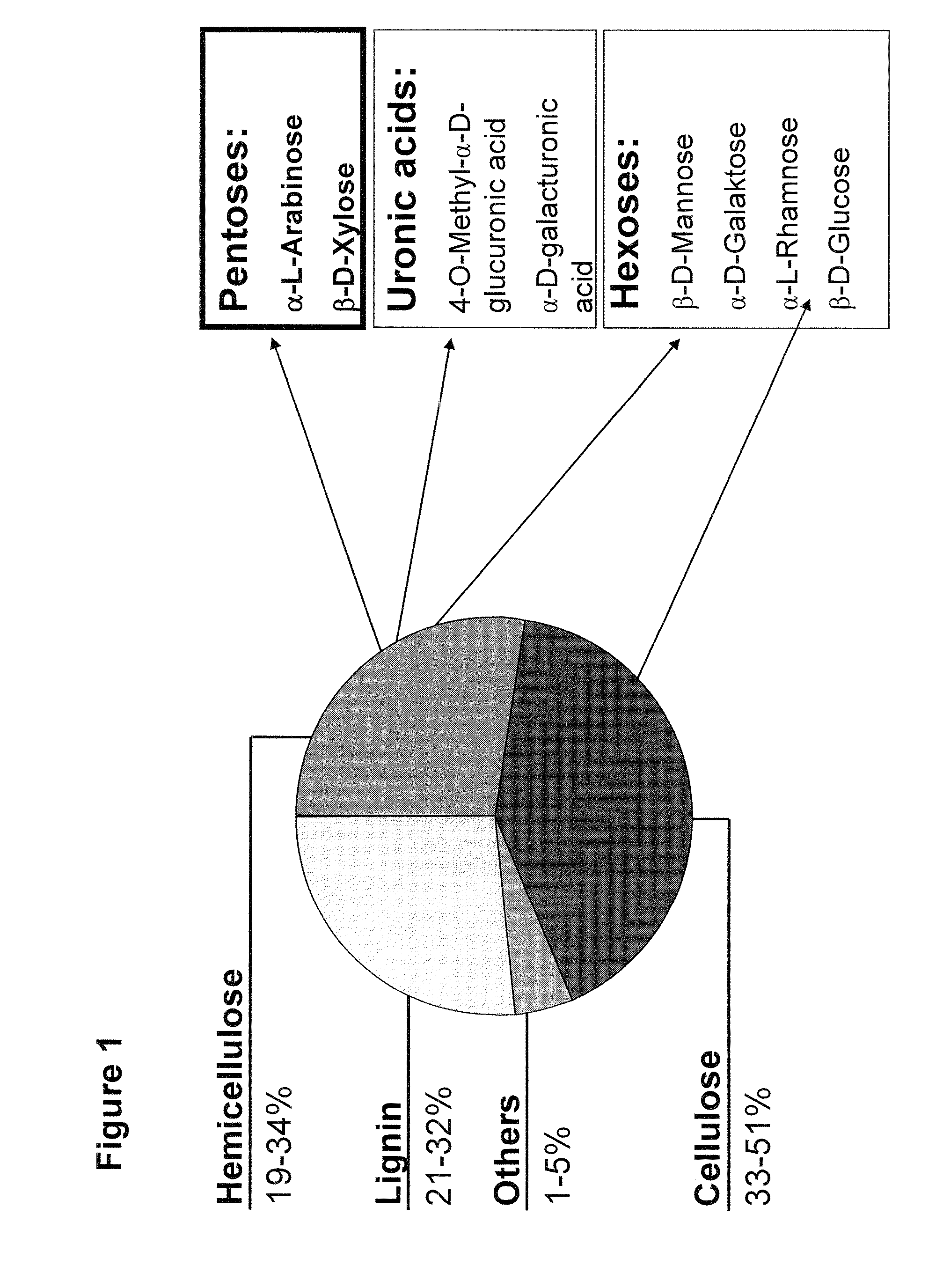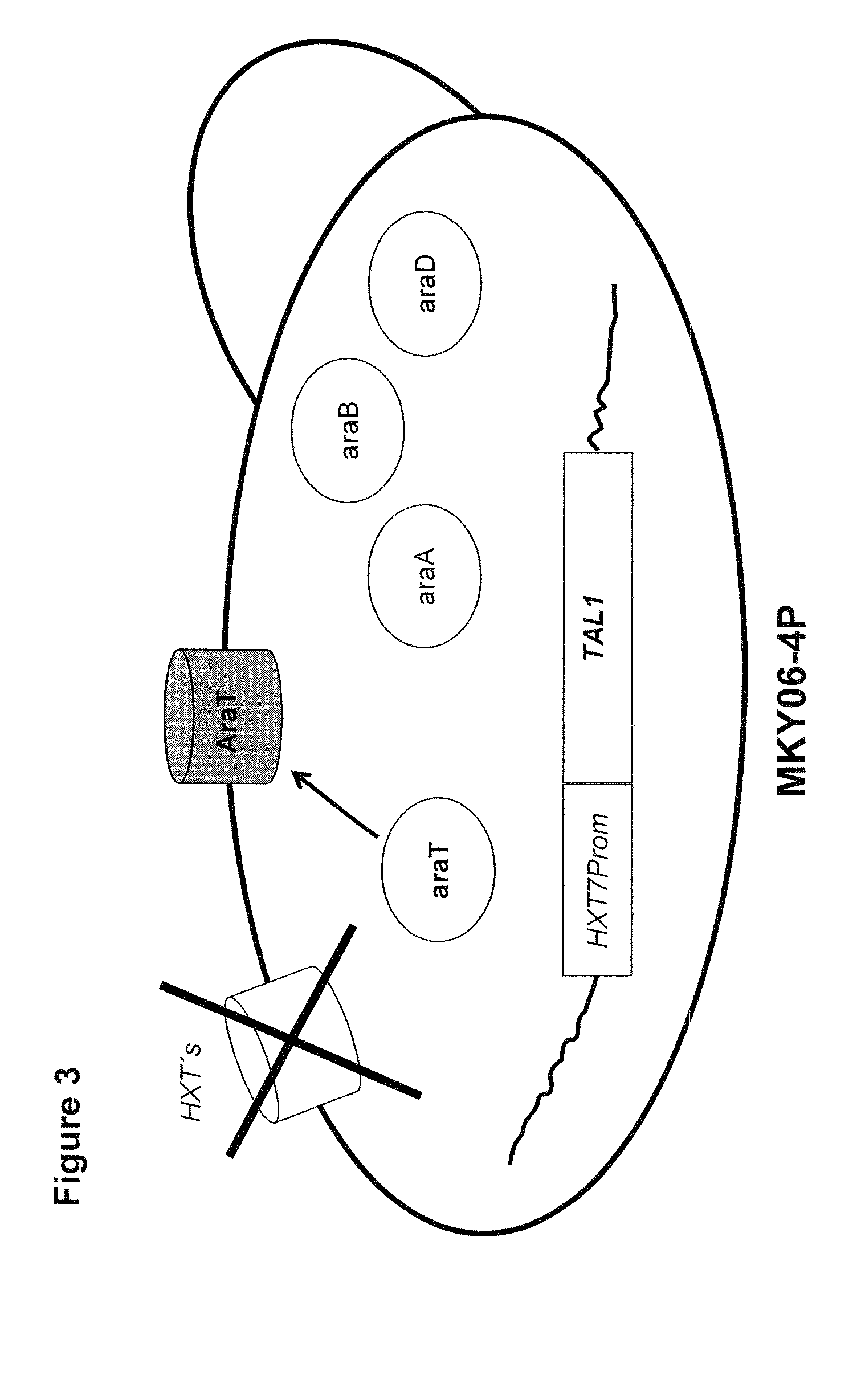Novel Specific Arabinose Transporter from the Yeast Pichia Stipitis, and Uses Thereof
a technology of pichia stipitis and transporter, which is applied in the direction of immunoglobulins, peptides, fungi/algae/lichens, etc., can solve the problems of low ethanol yield, lack of complete capacity of fermenting l-arabinose to ethanol, and little is known about the uptake of l-arabinos
- Summary
- Abstract
- Description
- Claims
- Application Information
AI Technical Summary
Problems solved by technology
Method used
Image
Examples
example 1
Design of a Test System for the Examination Of L-Arabinose Transporters
A) Construction of the MKY06
[0128]In the yeast strain EBY.VW4000 all the genes of the hexose transporter family and in addition three genes of the maltose transporter family were deleted. This strain grew on maltose medium unchanged, but was no longer able to grow on glucose, fructose and mannose and only very weakly on galactose (Wieczorke et al., 1999). As all hexose transporters are deleted, it can be assumed that the strain also can no longer receive any L-arabinose and is therefore suitable for arabinose transport investigations.
[0129]In preceding tests (see Becker and Boles, 2003), it had been found that in addition to a functional L-arabinose metabolic pathway, also an increased activity of transaldolase was necessary for the use of L-arabinose. For this reason, by exchange of the endogenous promoter of TAL1 in EBY.VW4000 for the shortened HXT7 promoter TAL1 was over-expressed. This strain was named MKY06 ...
example 2
Screen with a Pichia stipitis Gene Bank
[0134]The test system was now used in order to seek in a gene bank of Pichia stipitis one of the yeasts which can use L-arabinose, for possible L-arabinose transporter genes.
A) Carrying Out the Screen
[0135]The gene bank YEpTW which was used here was produced form the Pichia stipitis strain CBS5774. Chromosomal DNA was partially digested with the restriction endonuclease Sau3A and ligated into the vector Yep24 linearised with BamHI (Weierstall et al., 1999).
[0136]The gene bank, exactly like the plasmid pHL125′, had a uracil auxotrophy marker. The gene bank YEpTW was transformed into the strain MKY06-3P and smeared on SC medium with 2% maltose. The colonies obtained after three days at 30° C. were replica-plated on SC medium plates with 2% L-arabinose. After 10 days, colonies were sought which showed growth on L-arabinose. Growth was only possible when the plasmid of the gene bank coded a transporter which was able to transport L-arabinose.
[0137]...
example 3
Characterization of the Novel Arabinose Transporter (araT)
A) Sequencing
[0142]The chromosomal fragments from P. stipitis localized on the plasmids pAraT1 and pAraT7 found in Example 2 were sequenced.
[0143]The complete ORF of the transporter which was found was double-strand sequenced with overlapping regions. The promoter and terminator region was single-strand sequenced (cf. FIG. 5). The arrows indicate the regions of individual sequencings.
[0144]In the sequencing it was found that the two plasmids pAraT1 and pAraT7 contain overlapping fragments of the same gene. This concerns one and the same transporter and not two different transporter genes. The plasmid pAraT1 has an insert with approximately 5 kb; it contains the complete open reading frame (ORF) of AraT, which consists of 1629 bases and consequently 542 amino acids (plus the STOP codon). Additionally also promoter- and terminator sequences. The plasmid pAraT7 has an insert which is approximately 3 kb in size; it does not conta...
PUM
| Property | Measurement | Unit |
|---|---|---|
| Fraction | aaaaa | aaaaa |
| Fraction | aaaaa | aaaaa |
| Fraction | aaaaa | aaaaa |
Abstract
Description
Claims
Application Information
 Login to View More
Login to View More - R&D
- Intellectual Property
- Life Sciences
- Materials
- Tech Scout
- Unparalleled Data Quality
- Higher Quality Content
- 60% Fewer Hallucinations
Browse by: Latest US Patents, China's latest patents, Technical Efficacy Thesaurus, Application Domain, Technology Topic, Popular Technical Reports.
© 2025 PatSnap. All rights reserved.Legal|Privacy policy|Modern Slavery Act Transparency Statement|Sitemap|About US| Contact US: help@patsnap.com



